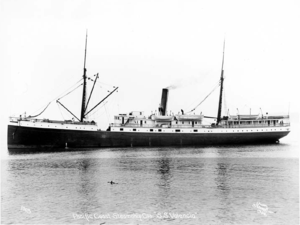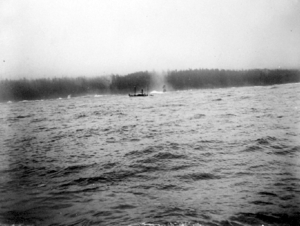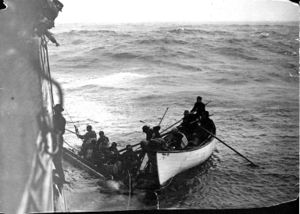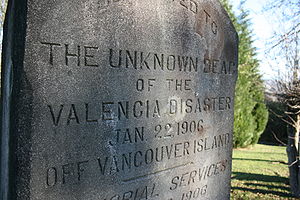
SS Valencia
Encyclopedia

Steamboat
A steamboat or steamship, sometimes called a steamer, is a ship in which the primary method of propulsion is steam power, typically driving propellers or paddlewheels...
wrecked off the coast of Vancouver Island
Vancouver Island
Vancouver Island is a large island in British Columbia, Canada. It is one of several North American locations named after George Vancouver, the British Royal Navy officer who explored the Pacific Northwest coast of North America between 1791 and 1794...
, British Columbia
British Columbia
British Columbia is the westernmost of Canada's provinces and is known for its natural beauty, as reflected in its Latin motto, Splendor sine occasu . Its name was chosen by Queen Victoria in 1858...
in 1906. Built in 1882 by William Cramp and Sons
William Cramp and Sons
thumb | upright | 1899 advertisement for William Cramp & Sons William Cramp & Sons Shipbuilding Company of Philadelphia was founded in 1825 by William Cramp, and was the preeminent U.S. iron shipbuilder in the 19th century. The American Ship & Commerce Corporation bought the yard in 1919 but closed...
, she was a 1,598 ton vessel, 252 feet (77 m) in length. Some consider the wreck of the Valencia to be the worst maritime disaster on the southwest coast of Vancouver Island, an area so treacherous it was known to mariners as the Graveyard of the Pacific
Graveyard of the Pacific
The Graveyard of the Pacific is a nickname for a stretch of the coastal region in the Pacific Northwest, from Tillamook Bay on the Oregon Coast northward to the tip of Vancouver Island...
.
Final voyage
The Valencia normally served the CaliforniaCalifornia
California is a state located on the West Coast of the United States. It is by far the most populous U.S. state, and the third-largest by land area...
–Alaska
Alaska
Alaska is the largest state in the United States by area. It is situated in the northwest extremity of the North American continent, with Canada to the east, the Arctic Ocean to the north, and the Pacific Ocean to the west and south, with Russia further west across the Bering Strait...
route. She was not equipped with a double bottom and, like other early iron steamers, her hull compartmentalization was primitive. In January 1906, however, she was temporarily diverted to the San Francisco–Seattle route to take over from the SS City of Puebla, which was undergoing repairs in San Francisco. The weather in San Francisco was clear, and the Valencia set off on January 20 at 11:20 AM with nine officers, 56 crew members and at least 108 passengers aboard. As she passed by Cape Mendocino
Cape Mendocino
Cape Mendocino located on the Lost Coast entirely within Humboldt County, California, USA, is the westernmost point on the coast of California. It has been a landmark since the 16th century when the Manila Galleons would reach the coast here following the prevailing westerlies all the way across...
in the early morning hours of January 21, the weather took a turn for the worse. Visibility was low and a strong wind started to blow from the southeast.
Unable to make celestial observations
Celestial navigation
Celestial navigation, also known as astronavigation, is a position fixing technique that has evolved over several thousand years to help sailors cross oceans without having to rely on estimated calculations, or dead reckoning, to know their position...
, the ship's crew was forced to rely on dead reckoning
Dead reckoning
In navigation, dead reckoning is the process of calculating one's current position by using a previously determined position, or fix, and advancing that position based upon known or estimated speeds over elapsed time, and course...
to determine their position. Out of sight of land, and with strong winds and currents, the Valencia overshot the entrance to the Strait of Juan de Fuca
Strait of Juan de Fuca
The Strait of Juan de Fuca is a large body of water about long that is the Salish Sea outlet to the Pacific Ocean...
by more than 20 miles (30 km). Shortly before midnight on January 22, she struck a reef
Reef
In nautical terminology, a reef is a rock, sandbar, or other feature lying beneath the surface of the water ....
near Pachena Point on the southwest coast of Vancouver Island.
Collision and disaster

In the ensuing confusion, six of the ship's seven lifeboat
Lifeboat (shipboard)
A lifeboat is a small, rigid or inflatable watercraft carried for emergency evacuation in the event of a disaster aboard ship. In the military, a lifeboat may be referred to as a whaleboat, dinghy, or gig. The ship's tenders of cruise ships often double as lifeboats. Recreational sailors sometimes...
s were lowered into the water against the captain's orders, all of them improperly manned. Three flipped while being lowered, spilling their occupants into the ocean; of the three that were successfully launched, two capsized and one disappeared. The scene at the wreck was horrific, as one of the few survivors, Chief Freight Clerk Frank Lehn recounted:
Only 12 men made it to shore, and of those three were washed away by the waves after landing. The remaining nine men scaled the cliffs and found a telegraph line strung between the trees. They followed the line through thick forest until they came upon a lineman's cabin, from which they were able to summon help. These nine men, who became known as the 'Bunker' Party, after the survivor Frank Bunker, eventually received much criticism for not attempting to reach the top of the nearby cliff, where they might have received and made fast, the cable fired from the Lyle gun
Lyle gun
Line-throwing guns are most often referred to as Lyle Guns, after their inventor David A. Lyle. They were used from the late 19th century to 1952, when they were replaced by rockets for throwing lines.-History:...
on board the Valencia .
Meanwhile, the ship's boatswain
Boatswain
A boatswain , bo's'n, bos'n, or bosun is an unlicensed member of the deck department of a merchant ship. The boatswain supervises the other unlicensed members of the ship's deck department, and typically is not a watchstander, except on vessels with small crews...
and a crew of volunteers had been lowered in the last remaining lifeboat with instructions to find a safe landing place and return to the cliffs to receive a lifeline
Lifeline
Lifeline or Lifelines may refer to:Non-Medical In-Home Services to the Elderly:* Lifeline utility, in New Zealand, an essential service during major emergencies* Crisis hotline:** Lifeline , Australia-based, now international...
from the ship. Upon landing, they discovered a trail and a sign reading "Three miles to Cape Beale." Abandoning the original plan, they decided to head toward the lighthouse
Lighthouse
A lighthouse is a tower, building, or other type of structure designed to emit light from a system of lamps and lenses or, in older times, from a fire, and used as an aid to navigation for maritime pilots at sea or on inland waterways....
on the cape, where they arrived after 2 ½ hours of hiking. The lighthouse keeper phoned Bamfield
Bamfield, British Columbia
Bamfield is a community that is surrounded by Crown Land, Indian Reserves, and portions of the Pacific Rim National Park, located on Barkley Sound, Vancouver Island in British Columbia. The community, with a population of 251 as of 2006, is divided by Bamfield Inlet.- History :Bamfield is populated...
to report the wreck, but the news had already arrived and been passed on to Victoria
Victoria, British Columbia
Victoria is the capital city of British Columbia, Canada and is located on the southern tip of Vancouver Island off Canada's Pacific coast. The city has a population of about 78,000 within the metropolitan area of Greater Victoria, which has a population of 360,063, the 15th most populous Canadian...
. This last group of survivors was "well-nigh crazed" by their last sight of the remaining stranded passengers
Rescue efforts

Marine salvage
Marine salvage is the process of rescuing a ship, its cargo, or other property from peril. Salvage encompasses rescue towing, refloating a sunken or grounded vessel, or patching or repairing a ship...
steamer Salvor and the tug
Tugboat
A tugboat is a boat that maneuvers vessels by pushing or towing them. Tugs move vessels that either should not move themselves, such as ships in a crowded harbor or a narrow canal,or those that cannot move by themselves, such as barges, disabled ships, or oil platforms. Tugboats are powerful for...
Czar. Another steamship, the SS City of Topeka, was later sent from Seattle with a doctor, nurses, medical supplies, members of the press, and a group of experienced seamen. On the morning of January 24, the Queen arrived at the site of the wreck
Shipwreck
A shipwreck is what remains of a ship that has wrecked, either sunk or beached. Whatever the cause, a sunken ship or a wrecked ship is a physical example of the event: this explains why the two concepts are often overlapping in English....
, but was unable to approach due to the severity of the weather and lack of depth charts
Nautical chart
A nautical chart is a graphic representation of a maritime area and adjacent coastal regions. Depending on the scale of the chart, it may show depths of water and heights of land , natural features of the seabed, details of the coastline, navigational hazards, locations of natural and man-made aids...
. Seeing that it would not be possible to approach the wreck from the sea, the Salvor and Czar set off to Bamfield to arrange for an overland rescue party.
Upon seeing the Queen, the Valencias crew launched the ship's two remaining life rafts, but the majority of the passengers decided to remain on the ship, presumably believing that a rescue party would soon arrive. Approximately one hour later, the City of Topeka arrived and, like the Queen, was unable to approach the wreck. The Topeka cruised the waters off the coast for several hours searching for survivors, and eventually came upon one of the life rafts carrying 18 men. No other survivors were found, and at dark the captain of the Topeka called off the search. The second life raft eventually drifted ashore on an island in Barkley Sound
Barkley Sound
Barkley Sound, also known historically as Barclay Sound, is south of Ucluelet and north of Bamfield on the west coast of Vancouver Island and forms the entrance to the Alberni Inlet...
, where the four survivors were found by the island's First Nations
First Nations
First Nations is a term that collectively refers to various Aboriginal peoples in Canada who are neither Inuit nor Métis. There are currently over 630 recognised First Nations governments or bands spread across Canada, roughly half of which are in the provinces of Ontario and British Columbia. The...
and taken to a village near Ucluelet.
When the overland party arrived at the cliffs above the site of the wreck, they found dozens of passengers clinging to the rigging and the few unsubmerged parts of the Valencias hull. Without any remaining lifelines, however, they could do nothing to help the survivors, and within hours a large wave washed the wreckage off the rocks and into the ocean. Every remaining passenger drowned.
Investigation and aftermath

Theodore Roosevelt
Theodore "Teddy" Roosevelt was the 26th President of the United States . He is noted for his exuberant personality, range of interests and achievements, and his leadership of the Progressive Movement, as well as his "cowboy" persona and robust masculinity...
. Its purpose was twofold: one, to determine the causes of the disaster, and two, to recommend how to avoid such loss of life in the future.
The investigation ran from February 14 to March 1, 1906, and the final report was published on April 14, 1906. The reports agreed on the causes of the disaster – navigational mistakes and poor weather. Safety equipment was, for the most part, in working order, but lifeboat drills had not been carried out. According to the report, the crew of the rescuing vessels did as much to help the Valencia as could be expected under the circumstances.
The loss of life was attributed to a series of unfortunate coincidences, aggravated by a lack of lifesaving infrastructure along Vancouver Island's coast. The federal report called for the construction of a lighthouse between Cape Beale and Carmanah Point, and the creation of a coastal lifesaving trail with regularly spaced shelters for shipwreck
Shipwreck
A shipwreck is what remains of a ship that has wrecked, either sunk or beached. Whatever the cause, a sunken ship or a wrecked ship is a physical example of the event: this explains why the two concepts are often overlapping in English....
ed sailors. It also recommended that surfboat
Surfboat
A surfboat is an oar-driven boat designed to enter the ocean from the beach in heavy surf or severe waves. It is often used in lifesaving or rescue missions where the most expedient access to victims is directly from the beach.-Construction:...
s be stationed at Tofino and Ucluelet and that a well-equipped steamboat be stationed at Bamfield. The Canadian government
Government of Canada
The Government of Canada, formally Her Majesty's Government, is the system whereby the federation of Canada is administered by a common authority; in Canadian English, the term can mean either the collective set of institutions or specifically the Queen-in-Council...
immediately set to work building a lighthouse and trail; in 1908, the Pachena Point Lighthouse
Pachena Point Lighthouse
Pachena Point Lighthouse is located on Vancouver Island, approximately 12 km south of Bamfield, British Columbia, in Pacific Rim National Park. The octagonal wooden tower is maintained by the Canadian Coast Guard who employ lighthouse keepers at the station.-External links:* *...
was lit, and in 1911 work on the trail – later known as the West Coast Trail
West Coast Trail
The West Coast Trail is a long backpacking trail following the southwestern edge of Vancouver Island in British Columbia, Canada. It was built in 1907 to facilitate the rescue of survivors of shipwrecks along the coast, part of the treacherous Graveyard of the Pacific...
– was completed.
Estimates of the number of lives lost in the disaster vary widely; some sources list it at 117, while others claim it was as high as 181. According to the federal report, the official death toll was 136 persons. Only 37 men survived, and every woman and child on the Valencia died in the disaster.
In 1933, 27 years after the disaster, the Valencias lifeboat #5 was found floating in Barkley Sound. Remarkably, it was in good condition, with much of the original paint remaining. The boat's nameplate is now on display in the Maritime Museum of British Columbia
Maritime Museum of British Columbia
The Maritime Museum of BC reflects the Pacific maritime history and culture of Canada's west coast, with an exhibits and public program mandate for research, education, and partnership.-History:...
.
The Valencias dramatic end has made it the subject of several local rumours and ghost stories. Five months after the incident, a local fisherman claimed to have seen a lifeboat with eight skeletons in a nearby sea cave
Cave
A cave or cavern is a natural underground space large enough for a human to enter. The term applies to natural cavities some part of which is in total darkness. The word cave also includes smaller spaces like rock shelters, sea caves, and grottos.Speleology is the science of exploration and study...
, but the party dispatched to investigate was unable to locate the cave.
In 1910, the Seattle Times reported that sailors claimed to have seen a phantom ship resembling the Valencia near Pachena Point.

